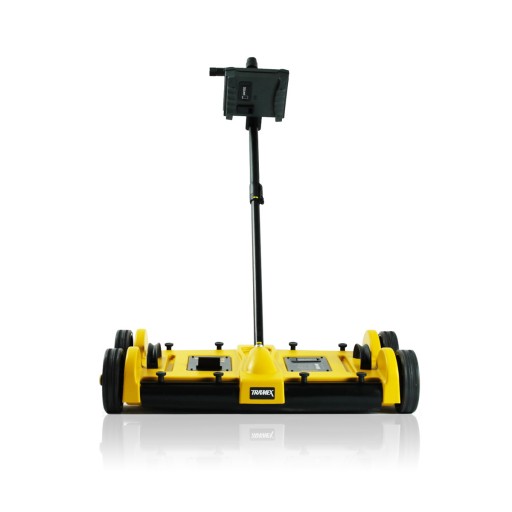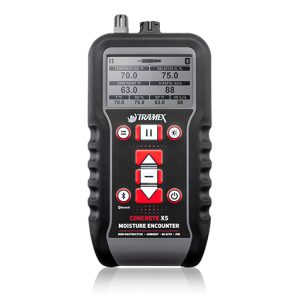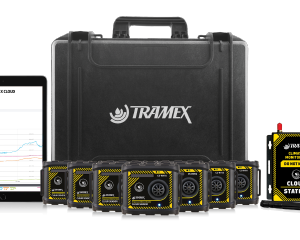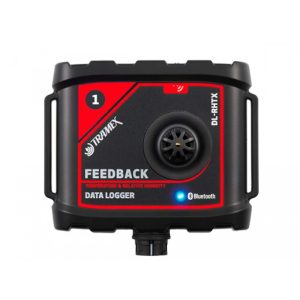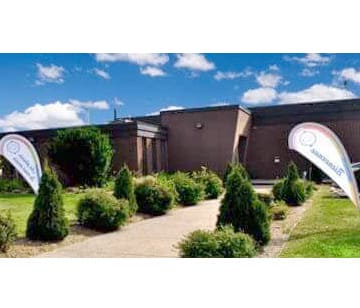Detect water leak detection with a Tramex non-destructive roof scanner. An instantaneous and clear indication of roof condition.
Ideal for instant surveying of moisture conditions in roofing and waterproofing systems per ASTM D7954 by non-destructively measuring the electrical impedance. Great for warranty auditing and quality control, as part of an ongoing maintenance program, or before re-roofing or repair of damaged roofs.
How does this roof scanner work?
The Dec Scanner roof moisture meter detects and measures leaks within the roofing structure. Featuring three ranges of sensitivity and with a maximum depth penetration of 6″ (152mm), the Dec Scanner enables the inspection of a variety of roof membranes and insulation thicknesses. Readings are instant and a flat roof area of up to 100,000 square feet can be reasonably covered in a day. As it is easy and safe to use with no regulatory restrictions or operating licenses required, the Dec Scanner is ideal for water leak detection and integrity testing in roofing materials. A low-frequency electronic signal is transmitted into the surface via an electrode incorporated in the rubber mat, and received by the second electrode. The strength of the signal depends on the amount of moisture. The strength of the current is converted to a comparative moisture content value. Easily identify locations with excessive moisture by passing the scanner across the roof.
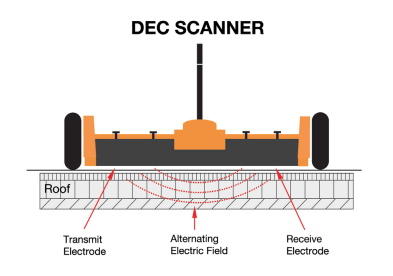
Operating Procedure
Moisture detection testing can be done at the time of installation for warranty auditing and quality control, as part of an ongoing maintenance program, or prior to re-roofing or repair of damaged roofs. The Dec Scanner is a durable but lightweight instrument that is easily transported to the roof surface. Having determined a known acceptably dry area, one of three sensitivity ranges is selected, and the Dec Scanner is ready to use. Without causing any damage to the roof surface, the Dec Scanner is moved over the tested area. The Dec Scanner gives continuous moisture condition readings, from which a moisture map of the surface can be drawn up, and leaks traced to their source.
Range Selection
The Dec Scanner has an integrated and adjustable calibration ability allowing for precise comparative readings. There are 3 Ranges, and they should be selected as best suits the surface under test, for example:
• Range 1 – Most suitable for single-ply and thin roof coverings such as PVC, Hypalon and other smooth surfaces where insulation is wet and moisture is close to the surface.
• Range 2 – Most suitable for multi-ply built-up and modified systems, mineral surfaced felts, and other smooth or gravel surfaces where insulation is less wet and moisture is below the surface.
• Range 3 – Most suitable for thicker roof coverings such as mastic asphalt, thick gravel and stone-surfaced roofing.
Features
- Complies to ASTM D7954
- Non-destructive
- Easily transported
- Three ranges of sensitivity for a variety of roof membranes and insulation thicknesses.
- Ergonomic easy-to-reach and easy-to-operate control panel.
- Leak tracing, water leak detection, problem sourcing,
- Instantaneous and clear indication of roof condition.
- Fast readings over large roof areas in a short time frame.
- Work in normal daylight hours.
- Faster and more user-friendly than nuclear meters.
- Easy and safe to use with no regulatory restrictions or operating license required.
- Dependable solid-state circuitry
- Rugged molded body.
- Battery powered – 9 Volt PP3.
Operating procedure:
Determine a known dry area, establish one of three sensitivity ranges and the Dec Scanner is ready to use. The moisture map of the surface is then drawn up, and leaks are traced to their source.
| Size: | 30”W x 15¾“D x 6¼”H (762 mm x 400 mm x 158 mm) |
| Scanning area: | 24”W x 15.5”D (609 mm x 394mm) |
| Carry case: | 38”W x 20”D x 10”H (940mm x 508 mm x 270mm) |
| Weight: | Dec Scanner 24.6 lbs (9.95 Kg) |
| Weight: | Carry Case 21.9 lbs (9.9 Kg) |
| Total Weight: | Dec Scanner in Carry Case 46.5 lbs (21.1 Kg) |
| Outer packaging carton weight: | 4.4 lbs (2 Kg) |
| Total shipping weight: | 51 lbs (23.1Kg) |
| Dimensional shipping weight: | 66 lbs (30 Kg) |
| Display: | 0 to 100 |
| Comparative Max. depth of penetration: | 6” (152 mm) |
| Power Supply: | 2 x 9 Volt PP3 Batteries (included) |
| Limitations: | Some EPDM, Butyl rubber roofing, and other conductive roofing. |
by Range selection:
The Dec Scanner has an integrated and adjustable calibration ability allowing for precise comparative readings. There are 3 Ranges, and they should be selected as best suits the surface under test, for example:
Range 1– Most suitable for single-ply and thin roof coverings such as PVC, Hypalon, and other smooth surfaces where insulation is wet and moisture is close to the surface.
Range 2– Most suitable for multi-ply built-up and modified systems, mineral surfaced felts, and other smooth or gravel surfaces where insulation is less wet and moisture is below the surface.
Range 3 – Most suitable for thicker roof coverings such as mastic asphalt, thick gravel, and stone-surfaced roofing
Detect water leak detection with a Tramex non-destructive roof scanner. An instantaneous and clear indication of roof condition.
Ideal for instant surveying of moisture conditions in roofing and waterproofing systems per ASTM D7954 by non-destructively measuring the electrical impedance. Great for warranty auditing and quality control, as part of an ongoing maintenance program, or before re-roofing or repair of damaged roofs.
How does this roof scanner work?
The Dec Scanner roof moisture meter detects and measures leaks within the roofing structure. Featuring three ranges of sensitivity and with a maximum depth penetration of 6″ (152mm), the Dec Scanner enables the inspection of a variety of roof membranes and insulation thicknesses. Readings are instant and a flat roof area of up to 100,000 square feet can be reasonably covered in a day. As it is easy and safe to use with no regulatory restrictions or operating licenses required, the Dec Scanner is ideal for water leak detection and integrity testing in roofing materials. A low-frequency electronic signal is transmitted into the surface via an electrode incorporated in the rubber mat, and received by the second electrode. The strength of the signal depends on the amount of moisture. The strength of the current is converted to a comparative moisture content value. Easily identify locations with excessive moisture by passing the scanner across the roof.

Operating Procedure
Moisture detection testing can be done at the time of installation for warranty auditing and quality control, as part of an ongoing maintenance program, or prior to re-roofing or repair of damaged roofs. The Dec Scanner is a durable but lightweight instrument that is easily transported to the roof surface. Having determined a known acceptably dry area, one of three sensitivity ranges is selected, and the Dec Scanner is ready to use. Without causing any damage to the roof surface, the Dec Scanner is moved over the tested area. The Dec Scanner gives continuous moisture condition readings, from which a moisture map of the surface can be drawn up, and leaks traced to their source.
Range Selection
The Dec Scanner has an integrated and adjustable calibration ability allowing for precise comparative readings. There are 3 Ranges, and they should be selected as best suits the surface under test, for example:
• Range 1 – Most suitable for single-ply and thin roof coverings such as PVC, Hypalon and other smooth surfaces where insulation is wet and moisture is close to the surface.
• Range 2 – Most suitable for multi-ply built-up and modified systems, mineral surfaced felts, and other smooth or gravel surfaces where insulation is less wet and moisture is below the surface.
• Range 3 – Most suitable for thicker roof coverings such as mastic asphalt, thick gravel and stone-surfaced roofing.
Features
- Complies to ASTM D7954
- Non-destructive
- Easily transported
- Three ranges of sensitivity for a variety of roof membranes and insulation thicknesses.
- Ergonomic easy-to-reach and easy-to-operate control panel.
- Leak tracing, water leak detection, problem sourcing,
- Instantaneous and clear indication of roof condition.
- Fast readings over large roof areas in a short time frame.
- Work in normal daylight hours.
- Faster and more user-friendly than nuclear meters.
- Easy and safe to use with no regulatory restrictions or operating license required.
- Dependable solid-state circuitry
- Rugged molded body.
- Battery powered – 9 Volt PP3.
Operating procedure:
Determine a known dry area, establish one of three sensitivity ranges and the Dec Scanner is ready to use. The moisture map of the surface is then drawn up, and leaks are traced to their source.
| Size: | 30”W x 15¾“D x 6¼”H (762 mm x 400 mm x 158 mm) |
| Scanning area: | 24”W x 15.5”D (609 mm x 394mm) |
| Carry case: | 38”W x 20”D x 10”H (940mm x 508 mm x 270mm) |
| Weight: | Dec Scanner 24.6 lbs (9.95 Kg) |
| Weight: | Carry Case 21.9 lbs (9.9 Kg) |
| Total Weight: | Dec Scanner in Carry Case 46.5 lbs (21.1 Kg) |
| Outer packaging carton weight: | 4.4 lbs (2 Kg) |
| Total shipping weight: | 51 lbs (23.1Kg) |
| Dimensional shipping weight: | 66 lbs (30 Kg) |
| Display: | 0 to 100 |
| Comparative Max. depth of penetration: | 6” (152 mm) |
| Power Supply: | 2 x 9 Volt PP3 Batteries (included) |
| Limitations: | Some EPDM, Butyl rubber roofing, and other conductive roofing. |
by Range selection:
The Dec Scanner has an integrated and adjustable calibration ability allowing for precise comparative readings. There are 3 Ranges, and they should be selected as best suits the surface under test, for example:
Range 1– Most suitable for single-ply and thin roof coverings such as PVC, Hypalon, and other smooth surfaces where insulation is wet and moisture is close to the surface.
Range 2– Most suitable for multi-ply built-up and modified systems, mineral surfaced felts, and other smooth or gravel surfaces where insulation is less wet and moisture is below the surface.
Range 3 – Most suitable for thicker roof coverings such as mastic asphalt, thick gravel, and stone-surfaced roofing






